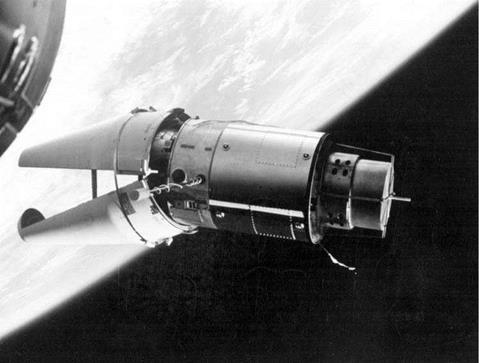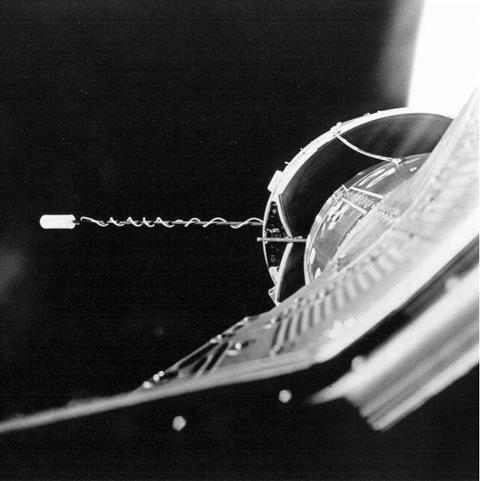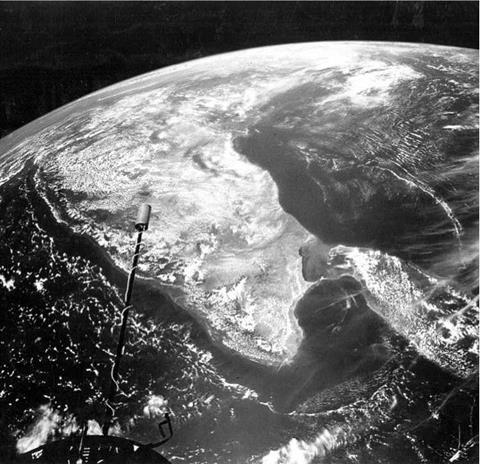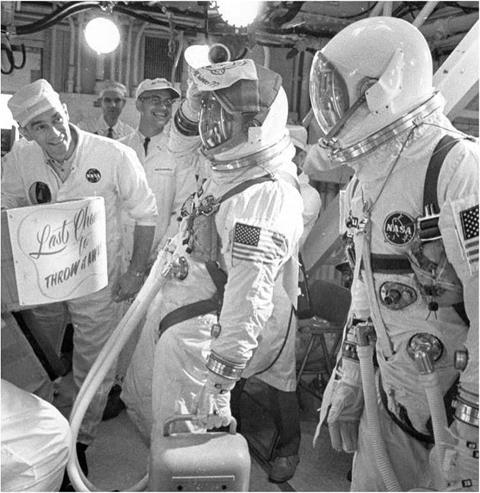GEMINI 9
|
Int. Designation |
1966-047A |
|
Launched |
3 June 1966 |
|
Launch Site |
Pad 19, Cape Kennedy, Florida |
|
Landed |
6 June 1966 |
|
Landing Site |
Western Atlantic Ocean |
|
Launch Vehicle |
Titan II GLV No. 9; spacecraft serial number 9 |
|
Duration |
3 days 20 min 50 sec |
|
Callsign |
Gemini Nine |
|
Objective |
Rendezvous and docking mission; EVA activities |
Flight Crew
STAFFORD, Thomas Patten Jr., 35, USAF, command pilot, 2nd mission Previous mission: Gemini 6 (1965)
CERNAN, Eugene Andrew, 32, USN, pilot
Flight Log
Gemini 9 certainly seemed to be a jinxed 13th US manned space flight, even before it got airborne. The prime Gemini 9 crew were killed in an air crash in St Louis on 28 February 1966, when their T-38 aircraft hit the roof of the building housing the Gemini 9 spacecraft, before bouncing off and crashing into a car park. Command pilot Elliott See and pilot Charles Bassett were replaced by the back-up crew, Tom Stafford and Eugene Cernan, who had landed at St Louis in a second aircraft shortly afterwards.
On 17 May, the Agena 9 target rocket for the three-day rendezvous, docking and spacewalking mission flew into the Atlantic Ocean after a second-stage malfunction, and the mission was scrubbed. After the Agena 6 failure in October 1965, NASA began to develop an alternative target without its own engine, called the Augmented Target Docking Adapter, ATDA, should the Agena fail again. On 1 June, an Atlas booster carried ATDA into orbit, while Stafford and Cernan waited for their blastoff within the tight, 40-second window. Computer problems grounded them at T — 2 minutes. Stafford, the Gemini 6 pilot, had now been to the pad five times and had lifted off only once.
However, he and Cernan were at last airborne at 08: 39 hrs on 3 June, heading for what scientists were expecting to be a rather unusual sight, as signals from the ATDA indicated that its payload shrouds had not separated fully. They were right. Stafford gave Gemini 9 its trademark, describing the ATDA as an “angry alligator”. They couldn’t dock but, as planned, backed off and conducted two more rendezvous. During the manoeuvres in the 28.9° inclination orbit, the astronauts reached a peak
|
The ATDA docking target was dubbed the “angry alligator” by the crew of Gemini 9 |
altitude of 311 km (195 miles). Cernan’s planned spacewalk was delayed to 5 June, because the astronauts felt exhausted.
The Gemini pilot was equipped with an enlarged EVA Life Support System (ELSS) on his chest, with its own heat exchanger to cool ventilator air and to provide 30 minutes of emergency oxygen. Cernan’s tether was 7.62 m (25 ft) long. He had planned to don the US Air Force manned manoeuvring unit, still attached to a tether, which was housed in the adapter section of the spacecraft. The AMU weighed 76 kg (168 lb) and was powered by nitrogen peroxide thrusters. Cernan’s legs were protected from the AMU’s exhaust by dark grey leggings of eleven layers of aluminised film. He donned the device but never flew it because Stafford called him back after a record 2 hours 8 minutes outside. Cernan found the spacewalk utterly exhausting, as controlling his movement in weightlessness was almost impossible. Compounding the problem were the snaking umbilicals of his spacesuit, the AMU, poor communications when Cernan switched to the AMU circuit, plus the inability of his spacesuit’s environmental control system to handle his body heat. Cernan ended up with a fogged faceplate and couldn’t see out.
Gemini 9 did, however, perform a party piece at the end of the 3 day 20 minute 50 second mission, splashing down just 1.44 km (1 mile) from the recovery ship
USS Wasp, a target miss of just 704 m (2,300 ft) some 552 km (343 miles) east of Bermuda.
Milestones
21st manned space flight
13th US manned space flight
7th Gemini manned flight
1st US manned space flight by back-up crew
2nd US and 3rd flight with EVA operations
Closest splashdown of a Gemini to a recovery vessel (0.38 nautical miles)

 |
Flight Crew
YOUNG, John Watts, 36, USN, command pilot, 2nd mission Previous mission: Gemini 3 (1965)
COLLINS, Michael, 36, USAF, pilot
Flight Log
The 299th Atlas (and the 100th NASA Atlas) vehicle took off from Pad 15 on 18 July, taking with it the Agena 10 target stage, which duly entered its programmed orbit. Astronauts John Young and Michael Collins were launched 100 minutes later at 17: 20 hrs, and within 5 hours 52 minutes were docked with Agena 10. Young had used rather too much fuel, however, and practice dockings were cancelled. The Taciturn Two, as the astronauts were described, used the Agena 10 engine to boost them into a record 763 km (474 miles) apogee in the 28.9° orbit, increasing the speed of the docked combination by 129 m/sec during the Agena’s 80-second burn. The boost captured the attention of the crew more than the scenery did, because with the huge stage before their windows, the view was limited. The crew rested for nine hours, and on the next mission “day’’ relit the Agena to reduce the orbital height in preparation for a rendezvous with the second target – the dead Agena 8 stage used during the Gemini 8 mission the previous March.
Before the rendezvous, Collins performed a stand-up EVA, standing on his seat and poking his head and shoulders out of the spacecraft hatch, mainly to set up an astronomical camera and to retrieve cosmic dust particle collectors from the outside of the spacecraft, two of the 16 science experiments being flown on the mission. During the 49-minute exercise, both astronauts were badly affected by leaking lithium hydroxide from the spacecraft’s environmental control system. Their eyes streaming and throats burning, they cut short the EVA. The Agena 10 was undocked after 38 hours 47 minutes attached to Gemini 10, while the latter, using its OAMS thrusters, made an optical rendezvous with the Agena 8 without the use of radar.
|
Gemini 10 docking with its Agena target, as seen from Mike Collins’ window |
On 20 July, Young piloted Gemini to within 3 m (10 ft) of the rocket stage and Collins opened the hatch for his full EVA, during which he recovered a cosmic dust particle collector from its side. He lost a camera in the process as he wrestled with a nitrogen gas-powered hand-held manoeuvring unit and the annoying tendency to float up and away from where he meant to be. A fault on another camera meant that no pictures were produced of Collins next to the Agena. The planned one-and-a-half – hour spacewalk was called off after 39 minutes because of concern over usage of the dwindling station-keeping thruster fuel. Getting the 15 m (49 ft) tether and the astronaut back into the spacecraft took a lot of effort and having done so, just before retro-fire, the crew opened the hatch for three minutes to dump some rubbish into orbit, namely the chest pack and tether.
Gemini 10 splashed down 846 km (526 miles) east of Cape Kennedy, 5.4 km (3 miles) from the recovery ship, USS Guadalcanal at T + 2 days 22 hours 46 minutes 39 seconds.
Milestones
22nd manned space flight 14th US manned space flight 8th Gemini manned flight 1st re-boost into high orbit
1st mission to rendezvous with two separate spacecraft 1st astronaut to make bodily contact with another spacecraft 1st US mission to launch on the day originally scheduled 3rd US and 4th flight with EVA operations

 |
Flight Crew
CONRAD, Charles “Pete” Jr., 36, USN, command pilot, 2nd mission Previous mission: Gemini 5 (1965)
GORDON, Richard Francis Jr., 37, USN, pilot
Flight Log
Gemini 11’s task was to simulate a take-off by an Apollo lunar lander, and rendezvous and docking with an Apollo Command Module in lunar orbit, by taking off and docking with the Agena 11 target within 94 minutes, or one orbit. This meant that after the successful ascent of Agena 11 on the delayed launch day of 12 September, Gemini 11 would have just two seconds in its launch window. Its Titan II booster met its target within half a second, spewing into life with that characteristic high-pitched whine as the hypergolic propellants ignited spontaneously on contact.
Once in 28.8° inclination orbit, Conrad and Gordon switched on their rendezvous radar and computer and the space chase began. Rendezvous was achieved within 85 minutes and the ebullient Conrad jockeyed Gemini’s nose inside the Agena target. For the first time in the programme, the crew performed docking practice, with Gordon being the first Gemini pilot to dock. The Agena was given a quick test burn in preparation for a longer burn later in the mission which was designed to take the crew to a record altitude.
On 13 September, after a rest, Gordon opened the hatch to begin an EVA, which everyone hoped would at last dispel doubts about man’s ability to work in space. The burly Gemini pilot floated towards the Agena docking collar and sat astride it to attach a tether. He used a 10 m (33 ft) tether and a hand-held manoeuvring unit. Riding like a cowboy, as Conrad described him, Gordon had great difficulty remaining in one place and not floating upwards. The effort proved too much for the spacesuit’s environmental control system and Gordon became blinded with sweat. Conrad called him back after just 38 minutes. Gemini had just one more flight to prove
|
Gemini 11 flies over India and Sri Lanka |
that effective EVA was possible. The crew overcame their disappointment with the big Agena burn, lasting 26 seconds, over the Canary Islands.
En route to a high point of 1,372 km (853 miles) over Western Australia, the highest Earth orbit manned apogee, Gordon took an epic photo of India and Sri Lanka from a height of about 800 km (497 miles). The Agena was used to reduce the orbital height, in preparation for a stand-up EVA by Gordon lasting 128 minutes, during which he conducted several of the mission’s science experiments and also had a cat nap.
Finally, Gemini 11 undocked from Agena 11, which was left dangling at the end of a 30 m (98 ft) tether. Conrad fired the thrusters to put the combination into a spin and thus created artificial gravity. After separating from the Agena and backing away, the crew performed further rendezvous exercises and a two-minute “equipment jettison” out of an opened hatch, before sitting back for a fully computer-controlled retro-fire, re-entry and landing. The eventful mission ended 1,120 km (696 miles) east of Miami, within 3 km (2 miles) of the recovery ship, USS Guam, at T + 2 days 23 hours 17 minutes 8 seconds.
Milestones
23rd manned space flight 15th US manned space flight 9th Gemini manned flight
1st manned mission to create artificial gravity in orbit 1st computer-controlled retro-fire re-entry and landing 4th US and 5th flight with EVA operations
On 1 November 1966, NASA civilian test pilot William Dana, 35, flew X-15-3 to 93 km during the programme’s tenth astro-flight.

 |
Flight Crew
LOVELL, James Arthur Jr., 38, USN, command pilot, 2nd mission Previous mission: Gemini 7 (1965)
ALDRIN, Edwin Eugene “Buzz” Jr., 36, USAF, pilot
Flight Log
Apart from the now customary Agena rendezvous and docking, the most important task of Gemini 12 was to overcome the perennial spacewalking problem. For this, astronaut Buzz Aldrin was to have the additional assistance of straps, harnesses, Velcro patches and even “golden slippers” spacesuit boot holders, to help keep him in place, so he could do really effective work without overworking his environmental control system. The crew walked to the pad with “The” and “End” cards on their backs and were told when they reached Gemini 12 that theirs was “the last chance… no reruns… show will close after this performance”. The show began with the Agena 12 launch from Pad 14 and followed that with Gemini 12’s lift-off at 15: 26hrs local time on 11 November. The flight achieved a 28.9° inclination orbit, which would at one point of the flight reach an apogee of 301 km (187 miles).
Fortunately, pilot Aldrin had written a thesis on manned orbital rendezvous before he was selected as an astronaut, so when the spacecraft’s rendezvous radar failed, his slide rule and sextant came out. To the admiration of ground controllers, rendezvous was achieved at T + 3 hours 46 minutes with a docking 28 minutes later. The astronauts had planned to use Agena’s engine for a modest re-boost to an altitude of 640 km (398 miles), but controllers were concerned about a potentially dangerous malfunction and instead ordered the crew to use the Gemini engines to perform “rendezvous” with a solar eclipse over South America, which was an added bonus to the mission. Aldrin then performed a 2 hour 39 minute stand-up EVA (SUEVA), taking photographs casually leaning over the spacecraft like a tourist.
The following day, 12 November, mission planners watched with some trepidation as Aldrin began the most important EVA so far. It went swimmingly and Aldrin
|
Astronaut Eugene Cernan (left) jokes with the Gemini 12 crew as they prepare to board the capsule |
did everything he planned during the successful 2 hour 8 minute spacewalk. One of his tasks had been to attach a tether to the Agena 12 target, which later allowed the astronauts to perform an artificial gravity test. On the third day, Aldrin opened the hatch again and made a 51-minute SUEVA, conducting some of Gemini’s 14 science experiments. Thruster problems continued to be a concern throughout the mission but did not prevent a safe re-entry and landing at T + 3 days 22 hours 34 minutes 31 seconds, just 4.16 km (3 miles) from USS Wasp. The Gemini programme had been concluded with ten manned missions, clocking up 80 man-days in space. What was remarkable was that throughout the programme, the Soviets did not launch one cosmonaut into space. America was on its way – to the Moon.
Milestones
24th manned space flight 16th US manned space flight 10th Gemini manned flight
1st manned mission to witness solar eclipse in space 5th US and 6th flight with EVA operations
The next US mission after the end of the Gemini programme should have been the mission of Apollo 1 in February 1967. The tragic events on 27 January 1967 which prevented this mission are covered in detail under the chapter Quest for Space (Chapter 2).














